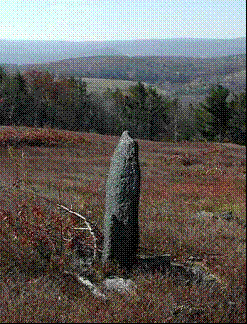BURNT HILL in Heath

By Faux Doe

Standing stone
When I was a child I sometimes roamed around Burnt Hill while my grandfather visited with Old Mr. Tripp (the father or grandfather of the later-years Tripp family owners.) Gramp had a camp in Heath that was fairly near the pond and the Burnt Hill area. We'd visit the camp on weekends when my grandparents were not busy in their store in Shelburne Falls. Gramp was familiar with old Mr. Tripp, and so while they were visiting, I pretty much had the run of the place. And I did always enjoy the view.
The nationally known artist, Robert Strong Woodward, had a camp built near the precipice of the hill, farther out than the Tripp house that was there in the 40s. Wheelchair-bound, I guess that this was his place of escape to go to paint and relax. His permanent residence was in Upper Buckland, Mass. Mr. Woodward's camp burned down in 1950, and thus now there would be a bulldozed pile or mound, probably containing stones from the structure's foundation and chimney. Today this would all be overgrown.
I was told that years ago, way back, that the native Indians raised blueberries on Burnt Hill. They actually farmed them, in effect, in the way that they burned-off the brush so that the blueberries could have a fresh start in the spring. The burning served to in a way to prune the blueberry bushes of excess growth. This seemed to help the next season's growth and berry bearing, and also the ash from the burning would fertilize the spring blueberry plants. From this seasonal burning to make the blueberries more prolific came the hill's name "Burnt Hill." (It was also known as "Blueberry Hill" to some.)
One day when Gramp was on another adjacent part of the hill, I wandered over towards the hill's precipice and Old Mr. Tripp was out in the field, wandering around and picking up rocks (the ones he could carry) and piling them up or in some cases putting them onto walls that were already there. He mentioned something about that they were thinking of extending the blueberry lot out past the house, so he was picking up rocks to sort of clear the land the best he could. He was not standing them up, he was merely randomly piling them or allocating to already existing piles. In New England piles of stones can mean nothing more than the fact that someone has cleared the land of stones in order to farm it. And if one picks up stones in that procedure, then they usually were placed in randomly spaced piles of varying sizes. If enough stones were available they would be used to build walls to keep the livestock enclosed. Such piles or walls had no special meaning other than being collections of rocks where someone had cleared the land at some time or another.
At this time when I was with Mr. Tripp out in the field I was young. My guess now is that I was probably 7 to 10 years old, not any more than that. I am almost 50 years old now so this would put my presence on the hill with old Mr. Tripp that day at about 40 or more years ago. He spotted me roaming the field and asked me what I was doing there. I told him that I was with my grandfather who was nearby over at an old abandoned building. With nothing else to do I started to help him pile rocks and of course being young I soon turned it into a game of sorts. I took a long rock that I had found on the ground and stood it on end, then piled more rocks around the bottom to prop it up so that it would stand. I was shocked upon seeing one of the photos on your web site (click here for link to web site) because it showed the same rock which I had stood up so many years ago--still standing. As I remember it, the long stone was a reddish sort of sandstone, slim, with a definite sharp point on one end. I set up this rock right on the edge of a little precipice on a ledge which dropped off a ways. Also back along the ridge of the ledge I had piled smaller piles of rocks on top of others, and these little piles formed a row down the top of the small ridge. I could have set one or two more long stones on the end and propped them, but I can't remember. I can, however remember that the tall pointy stone was the largest I set up.
Mr. Tripp was observing what I was doing and gruffed "Kids!--I don't know." He shook his head, chuckling. I resumed helping him pile some more stones and when we were done and were resting he gazed across the pasture field and noticed the stone I had set up and said "You know, if nobody knew the difference that stone almost looks like it belongs there that way." He continued, "you know, someone years down the road could find that and think that it was something really old and someone had set it there for a purpose . Nobody would know the difference." He smiled and winked at me and I got this devilish grin. I guess at that point the pace was set, because to my surprise by your picture of the stone (the stone still stands from the day that it was propped up there by me. ) The Tripps apparently never saw a reason to dismantle my erection and it remained upright through all these years.
I can remember asking old Mr. Tripp about some of the other stones, some upright in the field and he remarked "Oh that--the grand-kids did that when they were playing out here."
The white lone piece of quartz I can remember placing on the pile of stones as we were clearing the field. There are other stone formations in your pictures which I don't recognize though. It must be that they are from a different part of the hill clearing.
'You have pictured on your web site what looks like an ancient upright stone, a lone stone post. It looks very aged as if it had been in the ground a long time. That particular stone IS very ancient. Nobody that had owned the property could remember any purpose for it or anything about it other than it always had been there and that it was very old. It could have been a boundary stone in the old days. It could be a surveyor's marker. It could simply be a hitching post for horses which someone erected way back. Or it could have been a primitive burial marker. Many graves hastily placed around New England in colonial days were nothing more than piles of stones, or a simple upright unmarked stone.
Old Mr. Tripp did tell me to stay off the back side of the hill that sloped down, because he said that that was Indian land, most likely an Indian burial ground, thus sacred ground where whites were not supposed to trespass. Various parcels of the "Indian land" around New England are still honored by locals today as places of "no trespass" even though the Indians are long gone from the area. This area of Burnt Hill, according to Mr. Tripp at least, is one of these burial grounds.
The indigenous Indians of the area seemed to favor ledge precipices with scenic views of the hills for their sacred burial grounds. Also favored were hillsides overlooking brooks and rivers or waterfalls where there might be plentiful game or fishing holes. Or some times they chose the tableland pinnacles of hills or elevated fields.
I do not know much about the research that has been done on the supposed ancient stones of Burnt Hill. I have only heard that there have been studies done and some references to astral alignments of the stones etc.
Well, I can tell you right now that the only thing that the pointy stone which I put up years ago points to is a little boy's dream. And maybe that is why it has been respected for so many years and left there to stand untouched. And maybe, just maybe, some of the other stones, but maybe not all, are the same......whims of children or someone who just wanted to leave a mark on the by-way in their passing. Hey, a stone could have been put up by anyone traversing Burnt Hill just to celebrate the view alone, a way of saying: "Stop a minute and take a look at nature's beautiful wonder."
Scientific people can classify things readily, but often they fail to see the purely human side of situations. They sometimes fail to see that something can be there just for the sake of it being there, just there for no particular reason at all other than what was in the mind of the designer.
FauxDoe
2004

